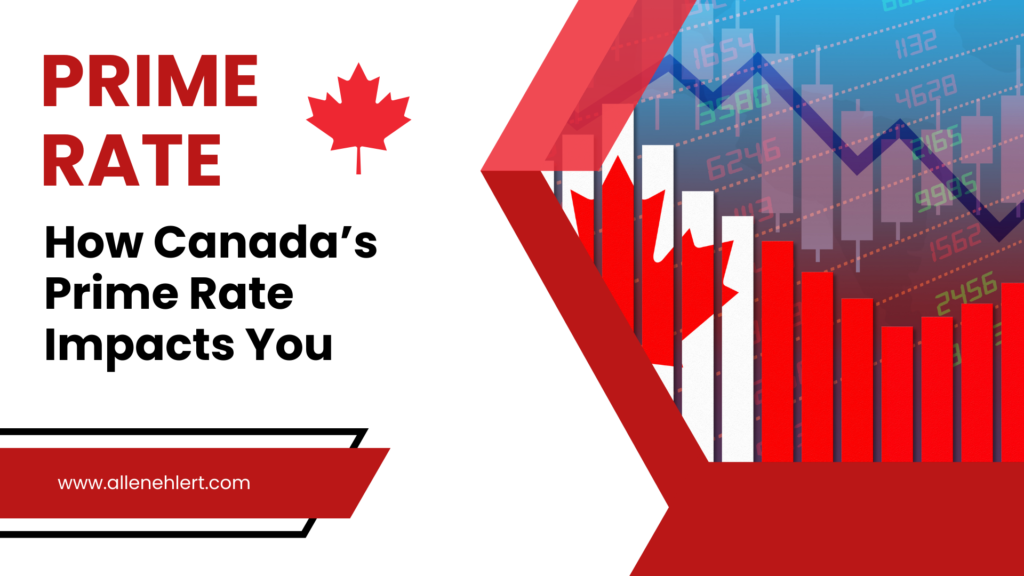How Canada’s Prime Rate Impacts You
In an economy where a mere quarter-point adjustment can send ripples across markets, it’s worth noting that Canada’s prime rate influences over CA$1.69 trillion worth of residential mortgages. This staggering figure underscores the vast reach of the prime rate into the pockets of Canadians, affecting not just mortgages but a wide array of financial products such as loans, lines of credit, and credit cards. As a key driver of interest rates movement, the role of the Bank of Canada is pivotal, especially when steering through the turbulent waves of a fluctuating prime rate. As you navigate the complexities of financial products, understanding the impact of Canada’s prime rate on your loans, savings, investments, and even business financing becomes essential.
Your financial well-being is closely intertwined with the trends of the prime rate. It influences how much interest you pay on your credit cards and the returns on your savings and investments. In times of economic uncertainty, the prime rate can be a barometer for change, making it a significant factor worth monitoring, especially by those concerned with their financial outlook. So whether you’re investing in your future, securing lines of credit, or contemplating the right mortgage plan, the prime rate holds a vital key to your financial decisions.
Key Takeaways
- The magnitude of Canada’s prime rate impacts, reaching over a trillion dollars in mortgages alone.
- Understanding your loans, lines of credit, and mortgage options in relation to the prime rate can lead to better financial decisions.
- Interest rates on credit cards, savings, and investments are all tied to the fluctuating prime rate, emphasizing its widespread influence.
- The Bank of Canada plays a crucial role in determining the prime rate, affecting various aspects of personal and business financing.
- Monitoring the prime rate can be an important aspect of financial planning, offering insights into potential cost changes and investment opportunities.
Understanding Canada’s Prime Rate

To fully grasp the intricacies of the financial landscape in Canada, becoming acquainted with Canada’s prime rate is indispensable. This benchmark rate is the lifeblood of various lending products and affects millions each day. Let’s dive into its definition, contributing factors, and connection to the Bank of Canada’s pivotal overnight rate.
What Is the Prime Rate?
The definition of Canada’s prime rate is straightforward yet powerful. It serves as a foundational interest rate from which financial institutions derive the rates applied to variable lending products. Whether you’re eyeing a new mortgage or a business loan, the prime rate often dictates the interest you’ll pay over time.
Factors Influencing the Prime Rate
Several factors affecting the prime rate constantly sway its trajectory. These factors include economic conditions, the demand for borrowing, and most notably, the policies of the Bank of Canada. Financial institutions keenly observe these elements before adjusting their prime rates accordingly, impacting your financial commitments.
The Prime Rate’s Relationship with the Bank of Canada’s Overnight Rate
The connection between the prime rate and the Bank of Canada’s overnight rate is undeniable. Financial institutions often calibrate their prime rate in response to changes in the overnight rate, a tool used by the central bank to manage liquidity and guide interest rates across the nation.
| Bank of Canada’s Overnight Rate | Canada’s Prime Rate | Impact on Lending Products |
|---|---|---|
| Decrease | Potential to Decrease | Lower interest for variable-rate loans and mortgages |
| Increase | Potential to Increase | Higher interest for variable-rate loans and mortgages |
| Stable | Typically Stable | Maintained interest rates, barring economic shifts |
By understanding these dynamics, you’re better positioned to predict changes in your interest payments and make informed decisions about your financial future in Canada.
Historical Fluctuations of the Prime Rate
The historical prime rate of Canada serves as a key metric, reflecting the nation’s economic health through its ups and downs over time. As you evaluate these fluctuations, you’ll notice a pattern closely linked to various economic indicators and policies enacted by the Bank of Canada. Such movements in the prime rate are not erratic; they are responses to the economic climate, both domestically and globally.
Examining past trends in the prime rate offers insight into how significant events in the economy, such as inflation, changes in the employment rate, or global financial crises, can influence the borrowing costs. Gazing back over the years, we can pinpoint when these rates scaled their peaks, corresponding with vigorous economic activity or nosedived in times of recession.
| Year | Prime Rate | Economic Indicators or Events |
|---|---|---|
| 1990 | 14.00% | Early 1990s recession |
| 1995 | 9.00% | Post-recession recovery |
| 2000 | 6.75% | Dot-com bubble burst |
| 2008 | 4.75% | Global financial crisis |
| 2015 | 2.70% | Commodity price shock |
| 2020 | 2.45% | COVID-19 pandemic impact |
These snapshots give you an appreciation for how the Bank of Canada moves the prime rate lever in response to broader economic pressures. Through these adjustments, the prime rate serves as both a reflection of existing economic conditions and a tool for monetary policy. When making financial decisions, keep an eye on these historical patterns—they often act as harbingers for the direction of future rates.
The Prime Rate and Your Mortgages
As a borrower in Canada, it’s crucial to understand the impact that the prime rate has on your financial commitments, especially with regard to variable-rate mortgages. The prime rate, which is set by the Bank of Canada, serves as a benchmark for interest rates applied to various mortgage products offered by financial institutions, influencing your mortgage payments significantly.
Variable-Rate Mortgages Explained
Variable-rate mortgages are a type of home loan where the interest rate can fluctuate with changes in the market’s prime rate. If you hold such a mortgage, this means that your monthly payments can go up or down. While this may introduce some uncertainty, these mortgages can be beneficial if interest rates decrease. Let’s dive into what these adjustments mean for you as a borrower.
How Prime Rate Changes Affect Your Mortgage Payments
When the prime rate changes, typically in response to decisions made by the Bank of Canada, your mortgage payments can either increase or decrease accordingly. A higher prime rate will translate into larger monthly payments, while a lower rate will reduce them. This variability underscores the importance of staying updated on prime rate trends as borrowers can plan their finances better and potentially save money over the lifespan of their mortgages.
| Impact of Prime Rate Change | Monthly Payments (Before) | Monthly Payments (After) | Total Mortgage Cost (Over 25 Years) |
|---|---|---|---|
| Prime Rate Increase by 0.5% | $1,500 | $1,575 | $472,500 |
| Prime Rate Decrease by 0.5% | $1,500 | $1,425 | $427,500 |
As seen in the table above, even a small change in the prime rate can lead to significant differences in both your monthly mortgage payments and the total amount paid over the term of your mortgage. Preparedness and an understanding of how these rates work will empower you to make informed decisions regarding your home financing options.
Prime Rate’s Effect on Lines of Credit and Loans
The prime rate set by financial institutions is a significant benchmark for both lines of credit and loans in Canada. This cardinal number influences the interest rates that you, as a borrower, will be subjected to when securing funds. Thus, fluctuations in the prime rate by the Bank of Canada can pivotally alter the cost of borrowing. When the prime rate inches upwards, so does the cost of borrowing through various credit products, from personal loans to home equity lines of credit.
If you have a line of credit or a variable rate loan, changes in the prime rate are especially pertinent to your financial landscape. Interest rates on these borrowing tools usually move in tandem with the prime rate. This means that with an increase in the prime rate, your repayment amounts could swell, influencing your budgeting and long-term financial plans. Conversely, when the prime rate drops, you could experience a reduction in your interest payments, potentially freeing up resources for other expenses or investments.
Here’s a table that illustrates how changes in the prime rate can affect the cost of borrowing:
| Prime Rate Change | Impact on Line of Credit | Impact on Variable Rate Loan |
|---|---|---|
| 0.25% Increase | Monthly payments rise, overall interest due increases | Length of loan may extend if payments stay the same |
| 0.25% Decrease | Monthly payments decrease, less interest paid over time | Total cost of borrowing reduces, loan paid off faster |
| 0.50% Increase | Substantially higher monthly payments, costlier debt | Higher lifetime cost of loan unless additional payments made |
The prime rate’s wax and wane can also impact on how much you are permitted to borrow. Financial institutions often link your borrowing limit on lines of credit to the prevailing interest rates. A lower prime rate might mean you can borrow more due to the reduced interest load you carry, while a higher prime rate could tighten lending capacities.
In navigating these borrowing dynamics, it’s useful to understand that financial institutions firmly anchor their prime rates to the policy direction set by the Bank of Canada. While individual circumstances differ, a keen eye on the prime rate can offer important signals about the broader financial environment you’re operating within.
Adaptability and financial acuity are essential when dealing with variable interest products. Staying abreast of the prime rate’s movements allows you to anticipate changes in your repayment schedules and adjust your financial strategies effectively.
By keeping informed on prime rate fluctuations and understanding their potential impact, you place yourself in a position of advance, ready to optimize your borrowing strategies and maintain fiscal health.
The Impact on Savings and Investments
As the prime rate fluctuates, it exerts a powerful influence on various financial aspects, including how much interest your savings accounts might accrue and the approach you should take towards different investment strategies. Understanding this dynamic is essential for aligning your financial strategies with the current economic landscape determined by the Bank of Canada’s interest rates.
How Savings Account Interest Rates Correlate with the Prime Rate
When the prime rate moves, it doesn’t do so in isolation—savings accounts often feel a direct impact. As a key reference point for interest rates, when the prime rate goes up, financial institutions typically follow suit by increasing the interest rates on savings accounts. This correlation means that as the prime rate rises, your savings could potentially earn more interest, enhancing your savings strategies. Conversely, a lower prime rate might diminish the return you receive on your deposits, hence, syncing your savings endeavors with the economic rhythms can benefit your financial health.
Investment Strategies in a Fluctuating Prime Rate Environment
In a climate where the prime rate is subject to change, your investment strategies require a nimble approach. It’s here that understanding the market and being aware of the implications of the prime rate become crucial. Adjusting your investment portfolio to mitigate risks and capitalize on potential opportunities presented by fluctuating interest rates is fundamental. Diversification, for example, is a time-tested method that can safeguard your investments against volatility in the prime rate. Here’s a closer look at potential investment strategies tailored to different prime rate scenarios:
| Prime Rate Scenario | Investment Strategy | Considerations |
|---|---|---|
| Rising Prime Rate | Shift towards fixed-income securities | Lock in interest rates before they potentially lower in response to a future decrease |
| Stable Prime Rate | Maintain a balanced mix of stocks and bonds | Benefit from the stability to build a robust, long-term portfolio |
| Decreasing Prime Rate | Consider growth stocks | Capitalize on lower borrowing costs leading to increased corporate profitability |
Adjusting your investments in response to the movements of the prime rate can be a savvy way to navigate through different economic seasons. Looking towards investment strategies that offer flexibility can position you to not only endure but possibly benefit from the fluctuations steered by the Bank of Canada’s prime rate decisions.
Credit Cards and the Prime Rate
When managing your finances, understanding the relationship between credit cards and the prime rate is crucial. Many credit card issuers set their variable rates based on the prime rate, meaning when the prime rate fluctuates, so too can the interest rates on your credit cards. If you’re a cardholder, changes to the prime rate can significantly influence your interest rates and consequently, your borrowing costs.
For individuals who demonstrate strong creditworthiness, the relationship between credit card interest rates and the prime rate can be particularly impactful. If the prime rate rises, even cardholders with excellent credit histories may see an increase in their borrowing costs. Conversely, a dip in the prime rate might reduce the interest expenses on your outstanding credit card balance, assuming your card’s interest rate is indeed tied to this benchmark.
| Prime Rate Change | Impact on Variable-Rate Credit Cards |
|---|---|
| Prime Rate Increase | Higher interest rates leading to increased borrowing costs |
| Prime Rate Decrease | Lower interest rates resulting in reduced borrowing costs |
| Stable Prime Rate | No immediate change in interest rates or borrowing costs |
If you’re navigating the world of credit cards, keep a close eye on the prime rate, as it is a clear indicator of potential changes to your financial obligations. By doing so, you will be better equipped to manage your credit wisely and anticipate the implications of rate adjustments on your budget.

Prime Rate Influences on Business Financing
Understanding the prime rate’s influence on business financing is essential for any company looking to manage its finances effectively. The prime rate, as a reference point for lending rates, directly impacts the interest rates on loans that businesses take out. Staying current with prime rate trends can help entrepreneurs and financial managers make more informed decisions about when and how to finance their operations. Let’s delve deeper into how the prime rate affects the borrowing costs for businesses and what strategies can be implemented for optimal cash flow management.
Assessing the Cost of Business Loans
If you’re exploring business financing options, it’s vital to consider how the prime rate affects loans. As a barometer for setting interest rates, the prime rate plays a pivotal role in determining your borrowing costs. When the prime rate rises, so does the interest rate on your business loan, leading to higher repayment amounts. Conversely, a drop in the prime rate could mean lower borrowing costs and an opportunity to invest or expand your business with more affordable credit. Evaluating the prime rate’s trajectory can be a strategic move, ensuring that you secure financing when conditions are most favorable for your business’s financial health.
Managing Cash Flow with Variable Interest Expenses
Cash flow management becomes all the more challenging when your business is subject to variable interest expenses that fluctuate with the prime rate. Businesses with loans whose interest rates are pegged to the prime rate need to remain agile, ready to adjust to increased costs when rates go up. One strategy for navigating these waters is to set aside a buffer within your budget to absorb potential interest rate hikes, thus safeguarding your cash flow. Additionally, consider speaking with financial experts to explore fixed-rate loan options, which could lock in your borrowing costs and provide a sense of predictability amidst variable market conditions. Ultimately, the goal is for your business to remain resilient, capable of thriving regardless of the ebb and flow of interest rates influenced by the prime rate.
Differences in Prime Rates Among Major Banks
When navigating the landscape of Canadian finance, understanding how prime rates differ among the country’s major banks is crucial. These variances can influence your decisions regarding where to secure the best lending rates. Let’s delve into the intricacies of prime rates set by these key financial players and how they are influenced by the Bank of Canada.
How Banks Set Their Prime Rates
The process of determining prime rates by lending institutions often appears opaque, but it’s grounded in specific financial fundamentals. Each bank’s prime rate is typically influenced by the overnight rate set by the Bank of Canada, which functions as a benchmark. However, these rates are also a product of individual bank policies and prevailing market conditions. The balance between competitive positioning and the need to maintain profitability plays a significant role in where these rates land.
Comparing Prime Rates Across Top Financial Institutions
Comparing prime rates offered by various financial institutions can be illuminating. Below is a generic overview of how you might see major banks position their prime rates:
| Financial Institution | Current Prime Rate | Notes |
|---|---|---|
| Bank A | 2.45% | Stable over the past quarter |
| Bank B | 2.50% | Recently increased by 0.05% |
| Bank C | 2.40% | Competitive rate offering |
Focusing attention on the nuances of these interest rates among major banks allows for a more informed comparison and ultimately aids in making more calculated financial decisions. It’s essential for borrowers to assess these rates keenly, as even small differences can lead to significant savings or costs in the long term.
Also Read: Why Different Banks Have Different Prime Rates
Adapting to Prime Rate Increases: Tips and Strategies
When faced with prime rate increases, adaptation through informed financial planning becomes crucial. Rate hikes can affect your mortgages, loans, and even your day-to-day budgeting. To mitigate the effects of a climbing prime rate, one must be proactive in reassessing financial strategies, honing budgeting skills, and exploring debt management options.
Refinancing your mortgage or loans can be a viable strategy to capitalize on lower interest rates before further rate hikes take effect. This can potentially reduce your monthly payments and overall interest paid over time. However, refinancing comes with its own costs and should be weighed carefully against the savings it could provide.
Plan for the long term with a sound budgeting framework that accounts not only for the present costs but also anticipates future prime rate increases. Make debt management a priority by paying down high-interest debts as swiftly as possible.
Here are practical steps to help you navigate through periods of rising prime rates:
- Review and tighten your budget to accommodate for higher interest expenses.
- Prioritize debt payments, focusing on high-interest debt first.
- Consider consolidating debts to simplify payments and potentially lower interest rates.
- Stay informed about the financial market and potential future prime rate changes.
- Consult with a financial advisor for personalized advice and planning.
| Action | Impact | Considerations |
|---|---|---|
| Refinance Mortgages/Loans | Lower monthly payments | Upfront costs, break penalties |
| Debt Consolidation | Streamlined payments, potential interest rate reduction | Loans terms, overall debt amount |
| Increased Budgeting | Improved debt management, better prepared for future rate hikes | May require lifestyle adjustments |
Remember, with careful planning and actionable strategies, you can steer through the tide of prime rate increases and maintain a stable financial course.
Future Projections of the Prime Rate
As we delve into the complex landscape of Canada’s economy, we see that forecasting the future prime rate involves meticulous analysis of various economic indicators. Understanding these indicators is pivotal for any stakeholder looking to anticipate changes in lending and borrowing norms. The Bank of Canada maintains a pivotal role in shaping these expectations, frequently influenced by both national and global economic signals. Here, we translate the jargon-heavy discourse on prime rate fluctuations into actionable knowledge for you.
Analyzing Economic Indicators for Prime Rate Predictions
Experts meticulously examine an array of economic indicators to interpret potential shifts in the future prime rate. Indicators like GDP growth, inflation rates, and employment statistics offer insights into the wellbeing of the economy. This is more than academic analysis; your awareness of these trends can significantly influence personal and business financial planning. The Bank of Canada often adjusts the prime rate in response to inflationary prospects, making such data a bellwether for rate predictions.
What Economists Are Saying About Future Rate Movements
Amidst the spectrum of expert opinions, consensus can be elusive, but the wisdom lies in the aggregate of predictions and advice. Renowned economists pour over past and current data to forecast the trajectory of the prime rate. While a definitive rate prediction may not always be achievable, considering these expert forecasts gives you a foundational understanding to brace for future impacts. As you make financial decisions, staying aligned with the economists’ insights on the future prime rate is an astute move.
Prime Rate
The prime rate is a fundamental component of Canada’s financial system, serving as a benchmark for setting interest rates on various products. Understanding its definition and significance is imperative for anyone engaging with financial institutions for loans, mortgages, or lines of credit. As a recap of what we’ve covered, let’s delve into the prime rate’s pivotal role.
The prime rate’s definition is straightforward—it is the interest rate that commercial banks offer to their most creditworthy customers. However, its reach extends far beyond this simple explanation. The prime rate influences the cost of borrowing not just for individuals but for the entire economy. This is because it’s used as a reference point (or benchmark) for setting rates on various credit products.
When discussing the significance of the prime rate, one must consider how it impacts daily financial decisions. It affects the interest rates you’re charged on personal loans, the rates you pay on your home’s mortgage, and the cost of accessing funds through a line of credit. Notably, when the prime rate fluctuates, it invariably affects payments and financial planning for countless Canadians.
| Financial Product | Impact of Prime Rate |
|---|---|
| Mortgages | Changes in prime rate can affect monthly repayments |
| Loans | Interest rates on personal loans are often tied to the prime rate |
| Lines of Credit | Accessible funds may become more or less expensive |
Ultimately, the prime rate is a key economic indicator that reflects the health of the national economy. Understanding its movements allows you to make more informed decisions regarding borrowing and investment strategies.
Conclusion
As we have explored throughout this article, the prime rate’s impact on the financial landscape is both far-reaching and significant. Your understanding of this pivotal interest rate is crucial when making informed financial decisions involving borrowing, saving, and crafting astute investment strategies. It’s imperative for you to remain vigilant, observing any alterations in the prime rate, as these changes can have a lasting effect on your financial health.
The Bank of Canada plays a pivotal role in adjusting the prime rate, which in turn influences the economy at large. Staying aware of these adjustments allows for better management of your finances. Whether you’re considering a new mortgage, a line of credit, or are looking to understand the implications for your savings, being equipped with knowledge about the prime rate furnishes you with the power to navigate financial conversations and decisions with confidence.
Borrower education is an essential toolkit in an unpredictable economic climate where interest rates may fluctuate. By fostering an understanding of financial principles, including the dynamics of the prime rate, you empower yourself to adapt and flourish, regardless of economic tides. Make it a priority to keep this knowledge current and to employ it wisely in managing your financial journey forward.
FAQ
What is the prime rate?
The prime rate is a base rate set by financial institutions that determines variable interest rates for lending products such as loans, mortgages, lines of credit, and credit cards.
What factors influence the prime rate?
The prime rate is influenced by factors such as the Bank of Canada’s overnight rate and the borrowing and lending activities of financial institutions.
How does the prime rate relate to the Bank of Canada’s overnight rate?
The prime rate is directly correlated with the Bank of Canada’s overnight rate. Changes in the overnight rate impact the prime rate set by financial institutions.
What are variable-rate mortgages?
Variable-rate mortgages are mortgages that have interest rates tied to the prime rate. These rates can fluctuate based on changes in the prime rate.
How do changes in the prime rate affect mortgage payments?
Changes in the prime rate can impact mortgage payments for borrowers with variable-rate mortgages. It is important to monitor the prime rate and understand its impact on monthly payments.
How does the prime rate affect lines of credit and loans?
Changes in the prime rate can impact borrowing costs and interest rates for individuals who rely on lines of credit or seek loans from financial institutions.
How does the prime rate correlate with savings account interest rates?
The prime rate can impact the interest earned on savings accounts. Changes in the prime rate can affect the interest rates offered on savings accounts and the potential growth of savings.
What investment strategies can be considered in a fluctuating prime rate environment?
Individuals can consider investment strategies that align with market conditions and take advantage of potential opportunities and risks arising from changing interest rates.
How does the prime rate affect credit card interest rates?
Some credit card interest rates are linked to the prime rate. Changes in the prime rate can impact borrowing costs for credit card users.
How does the prime rate impact business loans?
The prime rate has an impact on business financing and determines the borrowing costs associated with business loans. Assessing the cost of business loans in relation to the prime rate is essential.
How can businesses manage cash flow with variable interest expenses tied to the prime rate?
Managing cash flow for businesses with variable interest expenses tied to the prime rate can present challenges. Implementing strategies for navigating potential fluctuations in borrowing costs is crucial.
How do banks set their prime rates?
Banks determine their prime rates based on market conditions, the Bank of Canada’s overnight rate, and their own lending policies.
How can borrowers compare prime rates across different financial institutions?
Borrowers can assess and compare prime rates offered by major banks and other lending institutions to make informed decisions about financial products and services.
How should individuals adapt to prime rate increases?
Adapting to prime rate increases involves financial planning, budgeting, debt management, and considering the option of refinancing existing loans or mortgages.
How can individuals analyze economic indicators to predict future prime rate movements?
Analyzing economic indicators helps individuals make predictions about future prime rate movements. It is important to stay informed and monitor trends for potential rate changes.
What are economists saying about future prime rate movements?
Expert opinions and forecasts from economists provide insights into the potential direction of the prime rate. Understanding these viewpoints can help individuals plan for the future.












